Investigation on Hysteretic Behavior of Embedded PVC Pipe Confined Reinforced High Strength Concrete Columns
Abstract
1. Introduction
2. Experimental Program
2.1. Specimen Design and Preparation
2.2. Material Properties
- Ordinary portland cement of 42.5 MPa.
- Medium coarse river sand.
- Crushed rock aggregate, which had a maximum size of 20 mm and a minimum size of 5 mm.
2.3. Test Setup and Loading Process
3. Experiment Results and Analysis
3.1. Failure Modes
3.2. Hysteresis Curve
3.3. Skeleton Curve
4. Seismic Performance Index and Influence Factor Analysis
4.1. Ultimate Bearing Capacity
4.2. Ductility Coefficient
4.3. Energy Dissipation
4.4. Strength Degeneration
4.5. Stiffness Dissipation
5. Calculation and Formula Derivation of Ultimate Shear Bearing Capacity
5.1. The Shear Ultimate Bearing Capacity Calculated by the Standard Formula
5.2. Superposition Method to Calculate Ultimate Shear Bearing Capacity
- Neglect the contribution of the PVC pipe hoop on the shear strength of concrete;
- The PVC pipe meets the von Mises yield criterion;
- Axial pressure is evenly distributed along the cross-section of the specimens.
6. Conclusions
- (1)
- When the shear span ratio is not large (λ ≤ 2.5), the failure mode of the reinforced high-strength concrete column embedded PVC pipe is shear barocliny failure. The influence of the axial compression ratio, shear span ratio, and other parameters on the failure mode was not obvious.
- (2)
- Compared with the reinforced high strength concrete column restrained with the ordinary stirrup, the hysteretic curve of the high strength concrete column with the PVC pipe and steel tube inside is fuller, the peak load is increased, the strength attenuation in the later stage is slow, the decline section of the skeleton curve is gentle, the limit deformation is large, and the ductility is good.
- (3)
- The restraint effect of the PVC pipe and steel tube is similar, which can provide an effective restraint effect and effectively enhance the seismic energy dissipation and deformation capacity of the reinforced high strength concrete column.
- (4)
- For specimens with the same configuration of the PVC pipe, with the increase in the axial compression ratio and shear span ratio, the ductility becomes worse, and the value of PVC pipe diameter has an impact on its seismic performance. It is not that the larger the pipe diameter, the better; there is a problem with the value of the reasonable pipe diameter ratio.
- (5)
- The ductility of the high-strength concrete column can be effectively improved by adopting measures of the internal PVC pipe, and the displacement ductility coefficient is greater than 3 in most cases. The lateral displacement angle of the limit exceeds the limit of the displacement angle between the layers of the concrete frame in the code.
- (6)
- In order to facilitate the calculation of shear strength of the concrete column confined by the PVC pipe, a simplified calculation method is adopted. According to the formula of the current concrete specification, the safety surplus is about 25%.
Author Contributions
Funding
Acknowledgments
Conflicts of Interest
References
- Lieping, Y.; Xinzheng, L.; Peng, F.; Qazi, A.U.; Wang, X.L.; Lin, X.C. High strength and performance structural materials and the developments of modern engineering structures and the design theory. In Proceedings of the 1st International Forum on Advances in Structural Engineering, Beijing, China, 25–27 July 2006; pp. 208–250. (In Chinese). [Google Scholar]
- Fakharifar, M.; Chen, G. Compressive behavior of FRP-confined concrete-filled PVC tubular columns. Compos. Struct. 2016, 141, 91–109. [Google Scholar] [CrossRef]
- Xue, J.Y.; Zhang, X.; Ke, X.J.; Ma, L. Seismic resistance capacity of steel reinforced high-strength concrete columns with rectangular spiral stirrups. Constr. Build. Mater. 2019, 229. [Google Scholar] [CrossRef]
- Si, B.J.; Sun, Z.G.; Wang, D.S.; Wang, Q. Review of studies on the seismic behavior of high strength concrete columns with high strength transverse reinforcement. China Civ. Eng. J. 2009, 42, 1–9. (In Chinese) [Google Scholar]
- Shi, Q.X.; Yang, K.; Bai, L.G.; Zhang, X.; Jiang, W. Experiments on seismic behavior of high-strength concrete columns confined with high-strength stirrups. China Civ. Eng. J. 2011, 12, 9–17. (In Chinese) [Google Scholar]
- Lei, Z.; Dong, S.; Guo, J.; Zhou, T.; Qiu, P. Test study on seismic perfprmance of high-strength concrete columns with central reinforcement. J. Build. Struct. 2010, 12, 83–91. (In Chinese) [Google Scholar]
- Guohuang, Y.; Yiyan, C.; Ming, G.; Zhao, Q.-C. Study on behavior of concrete-filled square steel tube reinforced concrete columns subjected to axial compression. Prog. Steel Build. Struct. 2013, 15, 26–30. (In Chinese) [Google Scholar]
- Carl, C.E. Concrete Filled Structural Plastic Columns. J. Struct. Div. 1978, 104, 55–63. [Google Scholar]
- Houssam, T. Design equations for concrete columns confined with hybrid composite materials. Adv. Compos. Mater. 2001, 10, 127–138. [Google Scholar]
- Toutanji, H.; Saafi, M. Stress-strain behavior of concrete columns confined with hybrid composite materials. Mater. Struct. 2002, 35, 338–347. [Google Scholar] [CrossRef]
- Wang, J.Y.; Yang, Q.B. Investigation on compressive behaviors of thermoplastic pipe confined concrete. Constr. Build. Mater. 2012, 35, 578–585. [Google Scholar] [CrossRef]
- Wang, J.Y.; Yang, Q.B. Experimental research on mechanical properties of PVC-pipe concrete. J. Tongji Univ. Nat. Sci. 2009, 37, 929–933. (In Chinese) [Google Scholar]
- Askari, S.M.; Khaloo, A.; Borhani, M.H. Performance of polypropylene fiber reinforced concrete-filled UPVC tube columns under axial compression. Constr. Build. Mater. 2020, 231. [Google Scholar] [CrossRef]
- Qian, J.R.; Cui, Y.; Fang, X.D. Shear strength tests of concrete filled steel tube columns. China Civ. Eng. J. 2007, 40, 1–9. (In Chinese) [Google Scholar]
- Youssf, O.; Gawady, M.A.E.L.; Mills, J.E. Static cyclic behaviour of FRP-confined crumb rubber concrete columns. Eng. Struct. 2016, 113, 371–387. [Google Scholar] [CrossRef]
- Abdulla, N.A. Concrete filled PVC tube: A review. Constr. Build. Mater. 2017, 156, 321–329. [Google Scholar] [CrossRef]
- Patel, V.I. Analysis of uniaxially loaded short round-ended concrete-filled steel tubular beam-columns. Eng. Struct. 2020, 205. [Google Scholar] [CrossRef]
- GB50010-2010. Code for Design of Concrete Structures; China Academy of Building Research: Beijing, China, 2010. [Google Scholar]
- AIJ. Recommendations for Design and Construction of Concrete Filled Steel Tubular Structure; Architectural Institute of Japan (AIJ): Tokyo, Japan, 1997. [Google Scholar]
- BS 540025:2005. Steel Concrete and Composite Bridges—Part 5: Code of Practice for the Design of Composite Bridges; British Standard Institute: London, UK, 2005. [Google Scholar]
- Eurocode 4 (EC4). Design of Composite Steel and Concrete Structures—Part1-1: General Rules and Rules for Buildings; CEN: Brussels, Belgium, 2004. [Google Scholar]
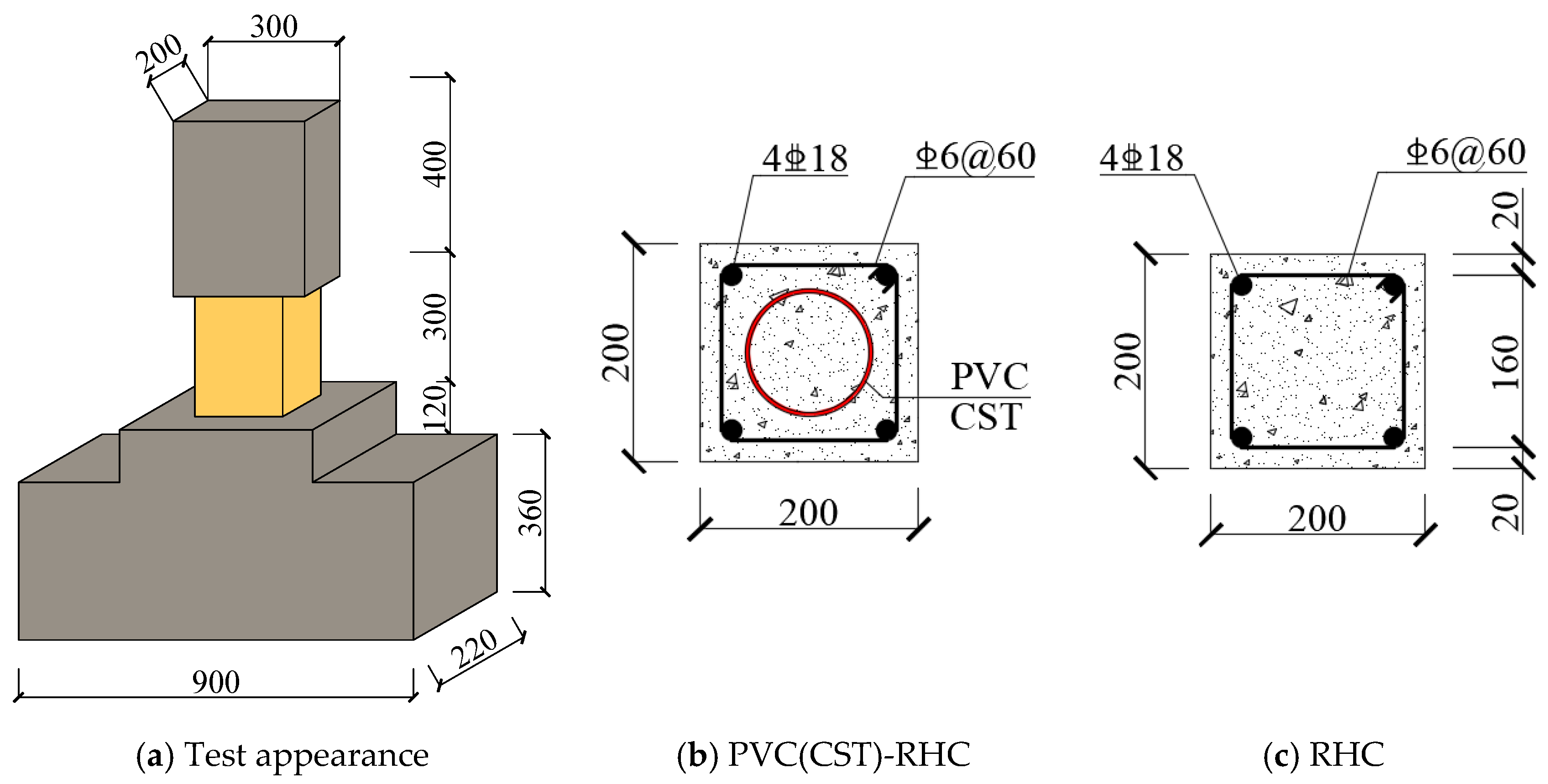
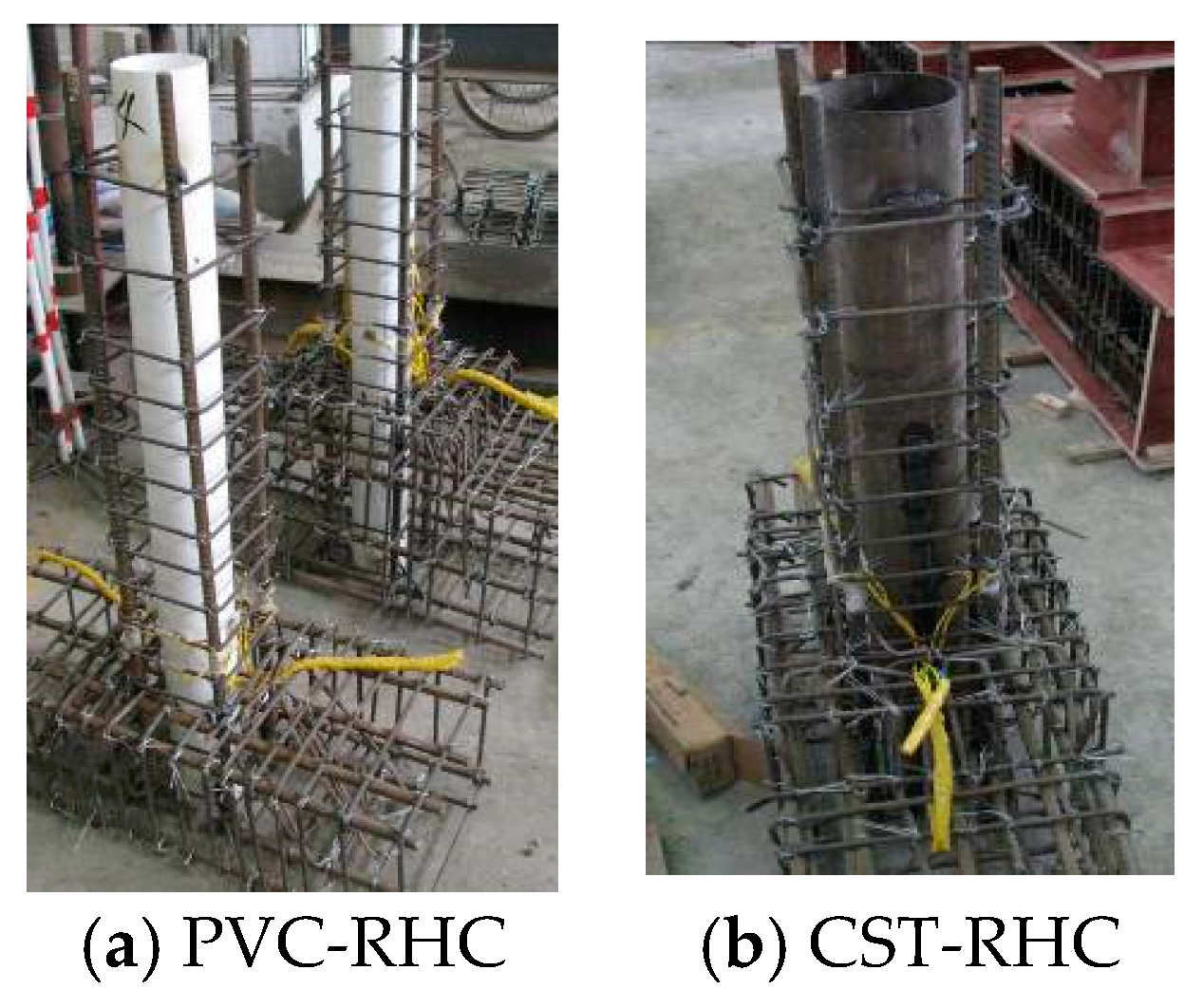
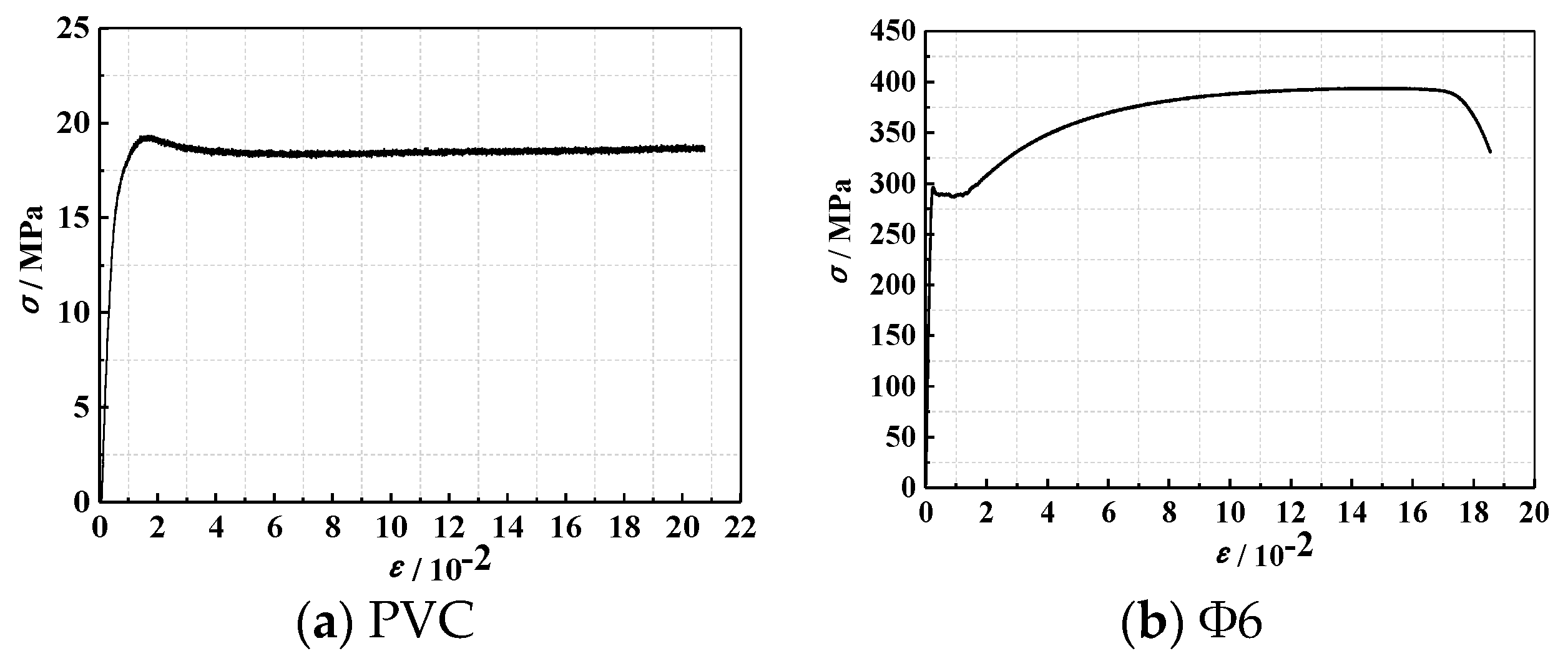
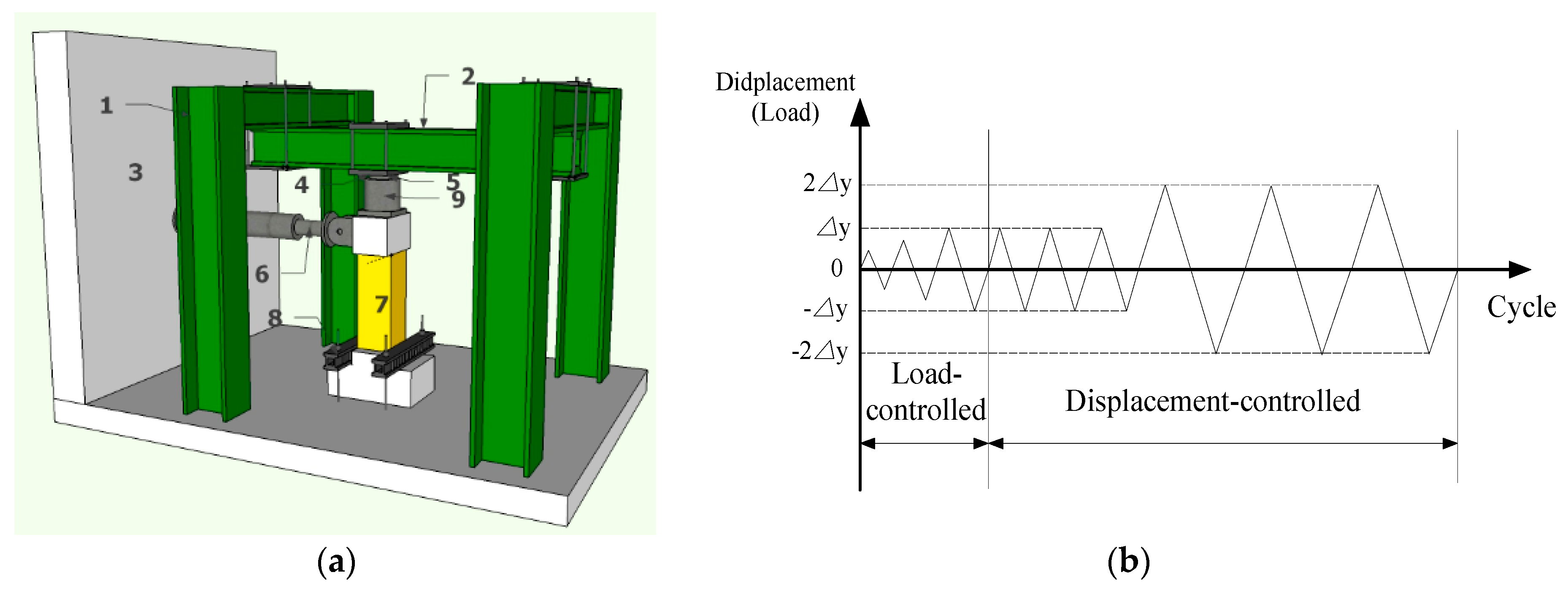
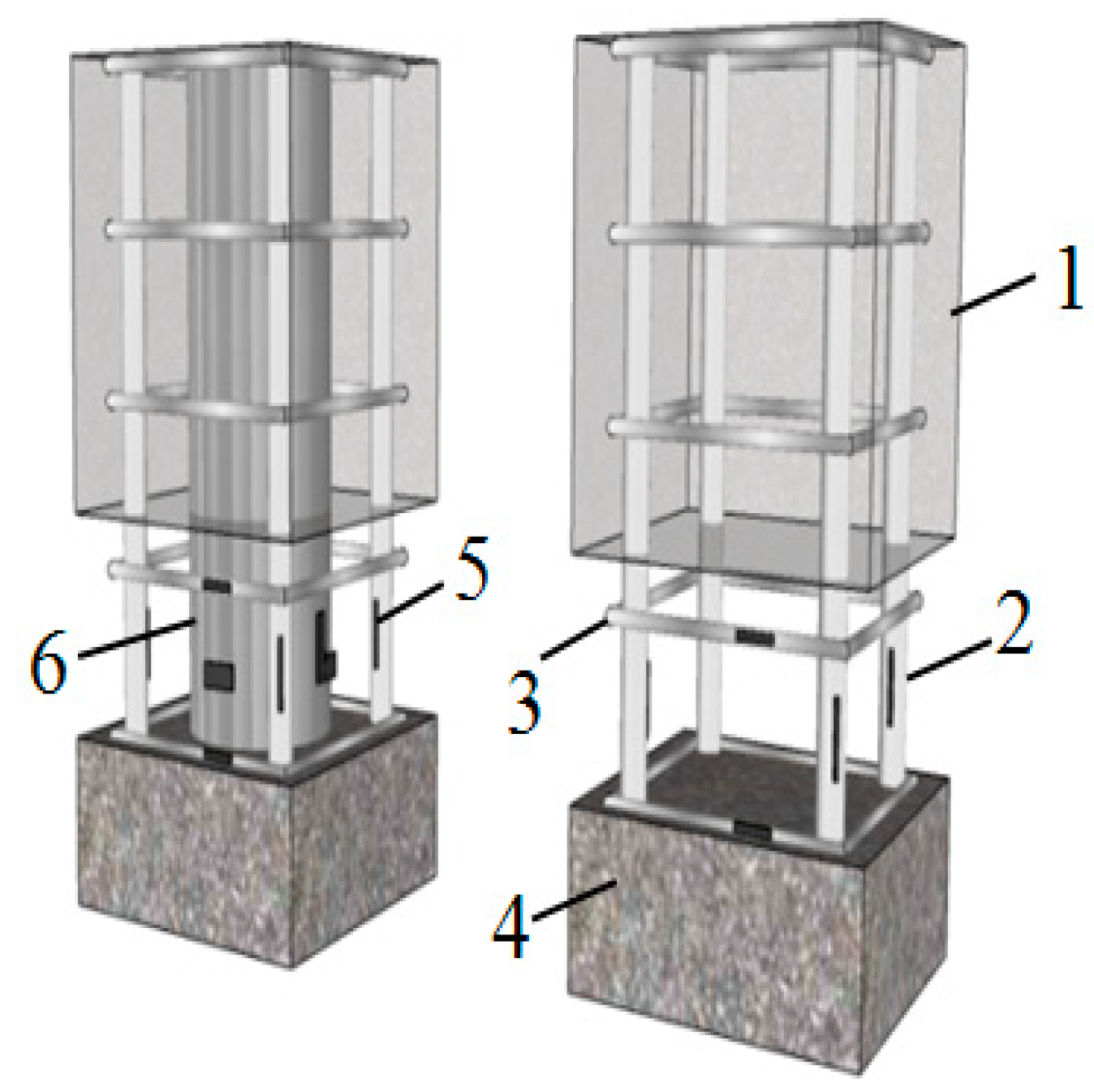

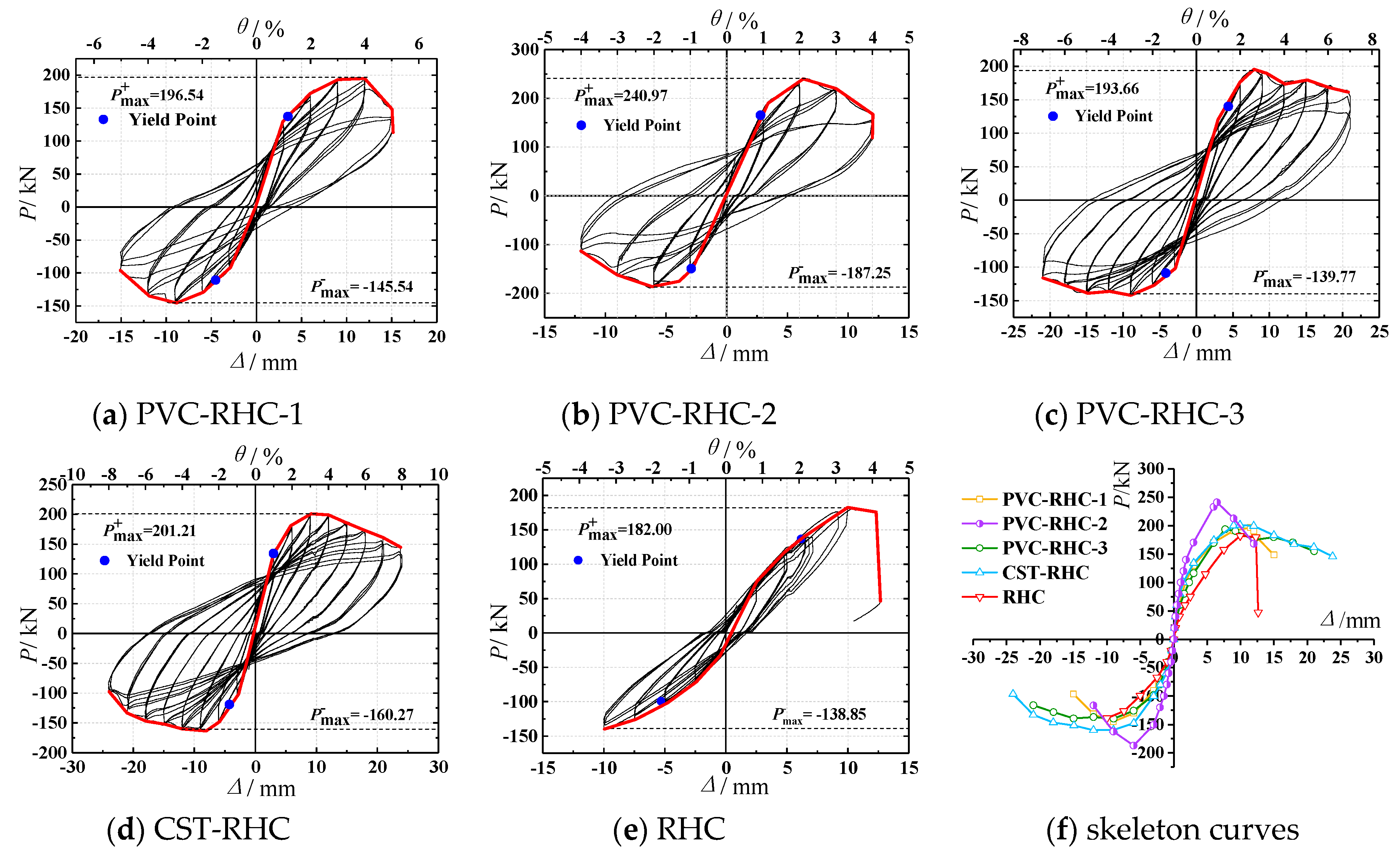
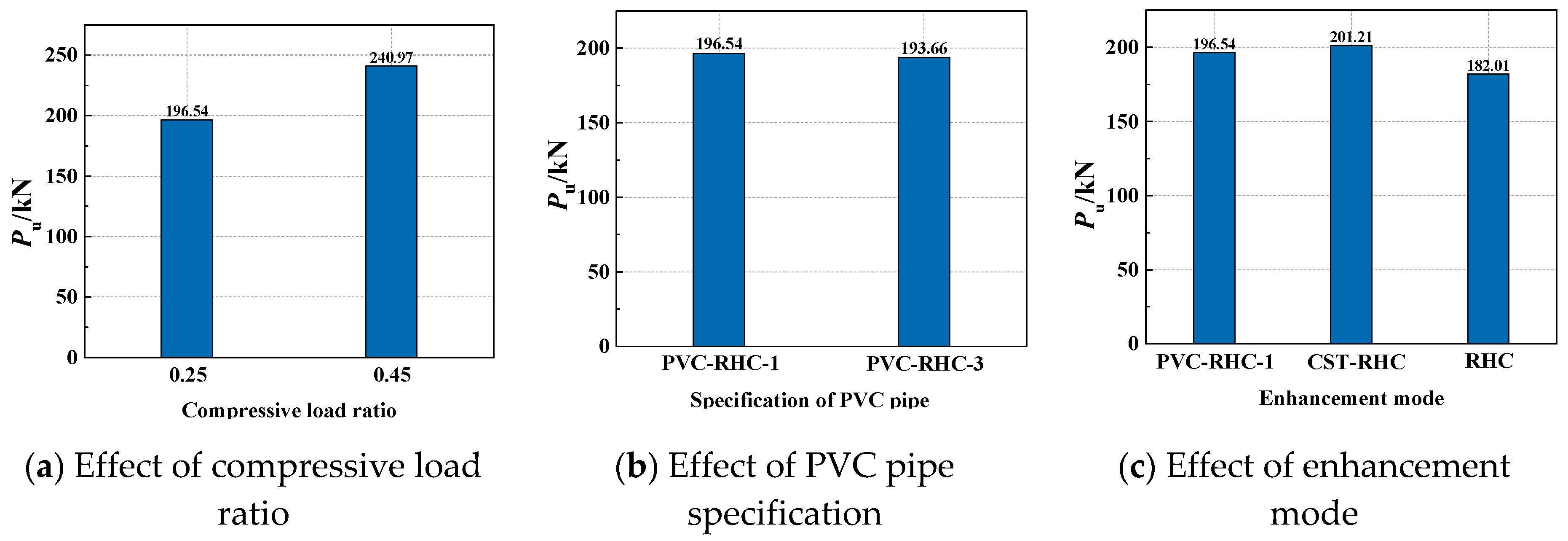



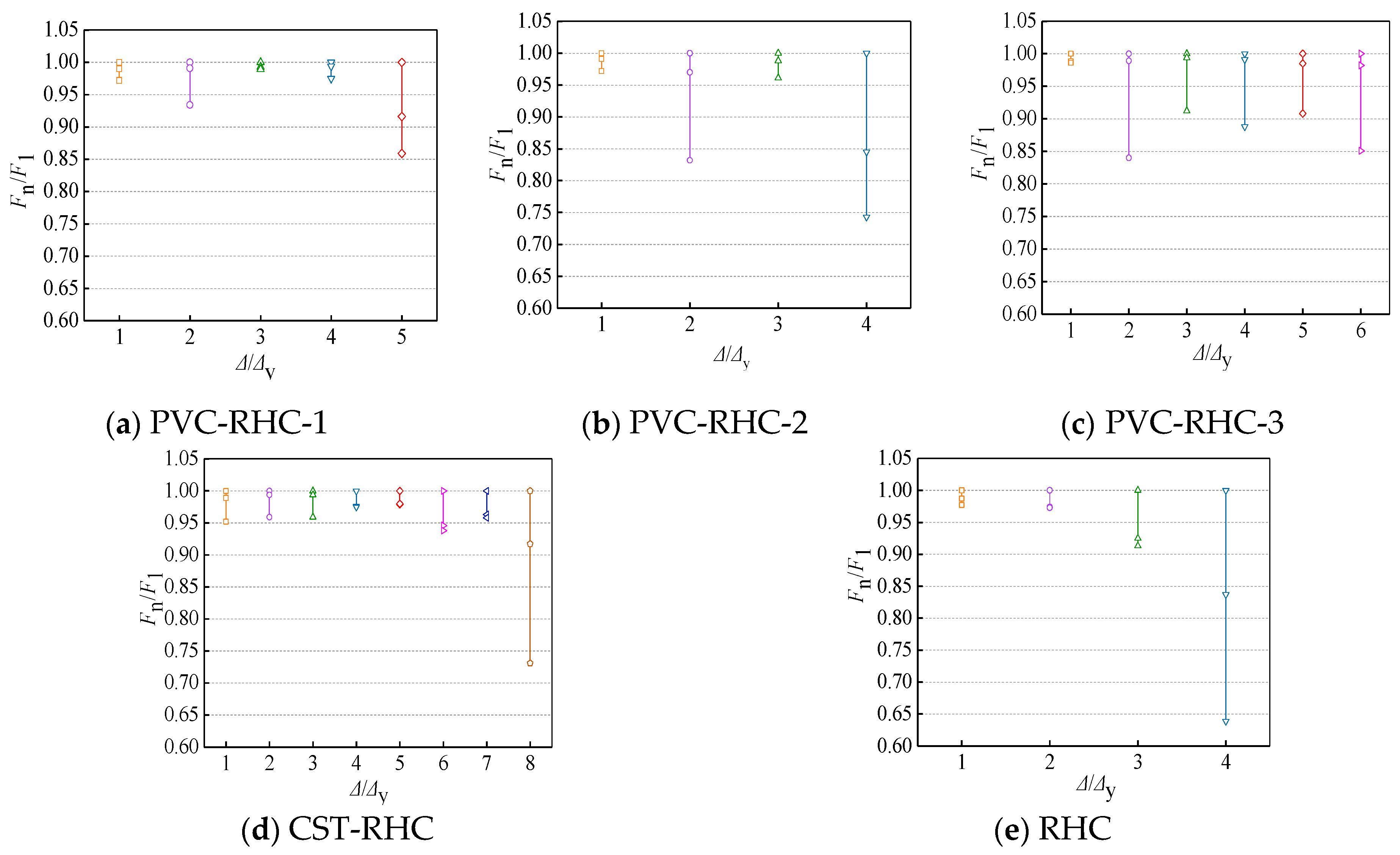
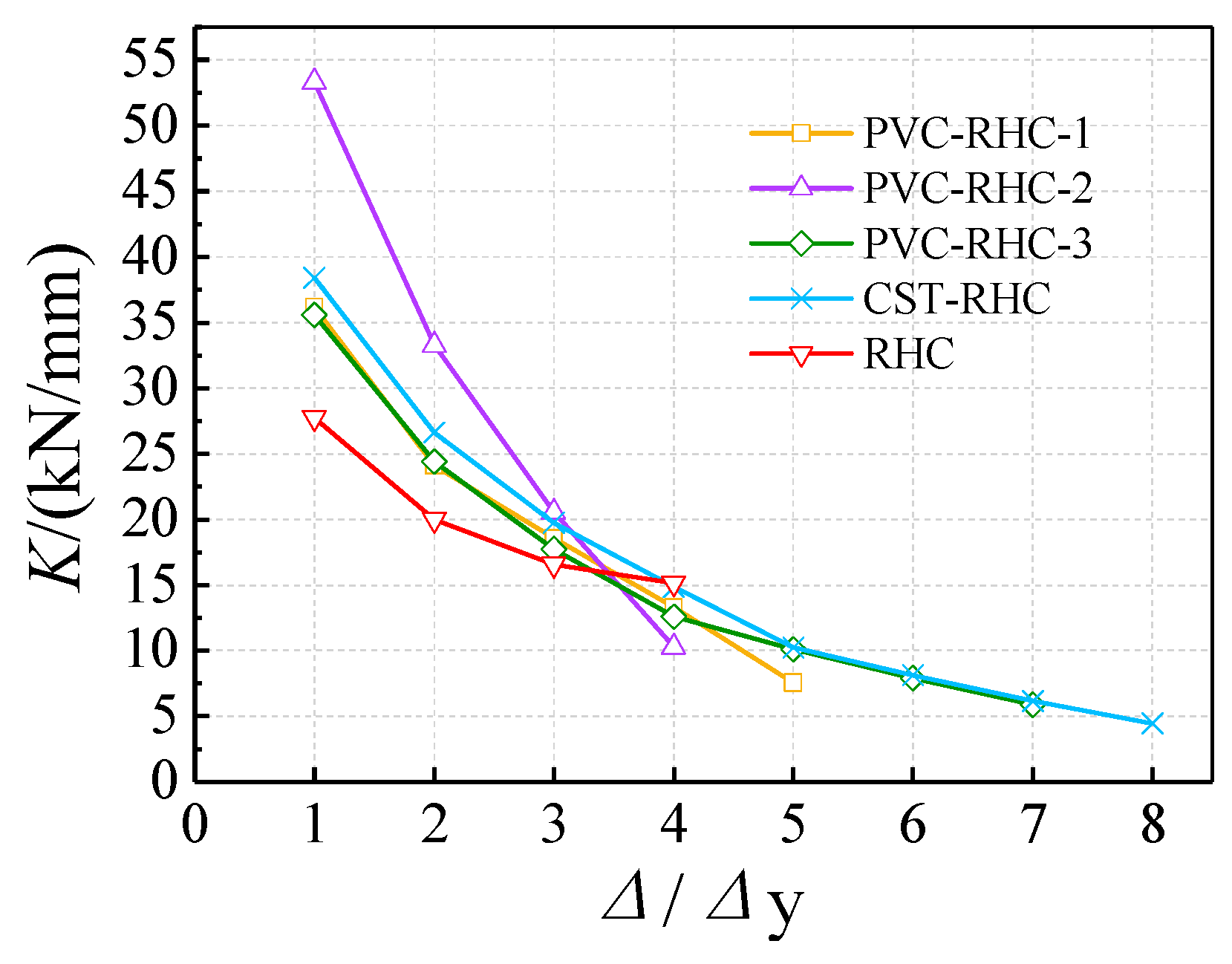



| Specimen | L (mm) | b × h (mm) | λ | n | Enhancements | Diameter | Longitudinal Reinforcement | Stirrup Form | Design Value of Concrete Strength |
|---|---|---|---|---|---|---|---|---|---|
| PVC-RHC-1 | 300 | 200 × 200 | 1.50 | 0.25 | PVC Pipe | Φ110 × 3 | 4C18 | B6@60 | C75 |
| PVC-RHC-2 | 300 | 200 × 200 | 1.50 | 0.45 | PVC Pipe | Φ110 × 3 | 4C18 | B6@60 | C80 |
| PVC-RHC-3 | 300 | 200 × 200 | 1.50 | 0.25 | PVC Pipe | Φ75 × 2.3 | 4C18 | B6@60 | C70 |
| CST-RHC | 300 | 200 × 200 | 1.50 | 0.25 | Round Steel Tube | Φ110 × 3 | 4C18 | B6@60 | C70 |
| RHC | 300 | 200 × 200 | 1.50 | 0.25 | Stirrup | Φ6 | 4C18 | B6@60 | C70 |
| Design of Value Concrete Strength | Material Content | |||||||
|---|---|---|---|---|---|---|---|---|
| Cement (kg/m3) | Sand (kg/m3) | Gravel (kg/m3) | Water (kg/m3) | Slag Powder (% of Cement Mass) | Silica Fume (% of Cement Mass) | Water Reducer (% of Cement Mass) | fcu (MPa) | |
| C75 | 482 | 664 | 1097 | 160 | 15 | 10 | 1.5 | 75.01 |
| C80 | 533 | 745 | 1117 | 160 | 15 | 10 | 1.5 | 79.44 |
| Category | Specification | fy (MPa) | fu (MPa) | Es (MPa) |
|---|---|---|---|---|
| Steel Bars | B6 | 277 | 380 | 1.798 × 105 |
| C18 | 465 | 644 | 2.017 × 105 | |
| Round Steel Tube | Φ110 × 3 | 392 | 499 | 2.191 × 105 |
| PVC pipe | Φ110 × 3 | − | 19.56 | 3315 |
| Φ75 × 2.3 | − | 20.20 | 3075 |
| NO. | Direction | Crack Point | Yield Point | Peak Point | Ultimate Point | ||||
|---|---|---|---|---|---|---|---|---|---|
| Pcr /kN | Δcr /mm | Py /kN | Δy /mm | Pm /kN | Δm /mm | Pu /kN | Δu /mm | ||
| PVC-RHC-1 | Push | 100 | 1.73 | 137.31 | 3.49 | 196.54 | 11.47 | 167.10 | 13.55 |
| Pull | 80 | 2.30 | 110.70 | 4.51 | 145.54 | 9.55 | 123.70 | 12.66 | |
| Average | 90 | 2.02 | 124.01 | 4.00 | 171.04 | 10.51 | 145.4 | 13.11 | |
| PVC-RHC-2 | Push | 140 | 1.84 | 165.40 | 2.79 | 240.97 | 6.49 | 204.82 | 9.53 |
| Pull | 140 | 2.69 | 149.36 | 2.92 | 187.25 | 6.00 | 159.16 | 9.18 | |
| Average | 140 | 2.27 | 157.38 | 2.86 | 214.11 | 6.25 | 181.99 | 9.36 | |
| PVC-RHC-3 | Push | 100 | 2.31 | 140.12 | 4.37 | 193.66 | 7.70 | 164.61 | 18.97 |
| Pull | 100 | 3.23 | 108.90 | 4.17 | 139.77 | 9.00 | 118.81 | 20.35 | |
| Average | 100 | 2.77 | 124.51 | 4.27 | 166.72 | 8.35 | 141.71 | 19.66 | |
| CST-RHC | Push | 120 | 2.38 | 134.27 | 2.98 | 201.21 | 9.91 | 171.03 | 17.31 |
| Pull | 100 | 3.00 | 119.15 | 4.23 | 160.27 | 12.01 | 136.23 | 20.31 | |
| Average | 110 | 2.69 | 126.71 | 3.61 | 180.74 | 10.96 | 153.63 | 18.81 | |
| RHC | Push | 100 | 3.95 | 136.72 | 6.16 | 182.00 | 9.96 | 179.66 | 12.30 |
| Pull | 100 | 3.86 | 99.29 | 5.32 | 138.85 | 9.99 | 138.85 | 9.99 | |
| Average | 100 | 3.91 | 118.01 | 5.74 | 160.43 | 9.98 | 159.26 | 11.15 | |
| NO. | Direction | Crack Point | Yield Point | Peak Point | Ultimate Point | Ductility Factor |
|---|---|---|---|---|---|---|
| θcr/% | θy/% | θm/% | θu/% | μ | ||
| PVC-RHC-1 | Push | 0.58 | 1.15 | 3.85 | 4.54 | 3.88 |
| Pull | 0.77 | 1.49 | 3.23 | 4.17 | 2.81 | |
| Average | 0.68 | 1.32 | 3.54 | 4.36 | 3.35 | |
| PVC-RHC-2 | Push | 0.61 | 0.93 | 2.17 | 3.23 | 3.42 |
| Pull | 0.89 | 0.97 | 1.59 | 3.03 | 3.14 | |
| Average | 0.75 | 0.95 | 1.88 | 3.13 | 3.28 | |
| PVC-RHC-3 | Push | 0.77 | 1.45 | 2.56 | 6.25 | 4.34 |
| Pull | 1.08 | 1.39 | 3.03 | 6.67 | 4.88 | |
| Average | 0.92 | 1.42 | 2.80 | 6.46 | 4.61 | |
| CST-RHC | Push | 0.79 | 0.99 | 3.33 | 5.88 | 5.81 |
| Pull | 1.00 | 1.41 | 4.00 | 6.67 | 4.8 | |
| Average | 0.90 | 1.20 | 3.67 | 6.27 | 5.31 | |
| RHC | Push | 1.32 | 2.04 | 3.33 | 4.17 | 2.00 |
| Pull | 1.28 | 1.79 | 3.33 | 3.33 | 1.88 | |
| Average | 1.30 | 1.91 | 3.33 | 3.75 | 1.94 |
| NO. | λ | b (mm) | h (mm) | Stirrup Form | ftk (MPa) | fyv (MPa) | N (kN) | Vt (kN) | Vc (kN) | Vt /Vc | Note |
|---|---|---|---|---|---|---|---|---|---|---|---|
| PVC-RHC-1 | 1.5 | 200 | 200 | Φ6@60 | 4.62 | 277 | 480 | 196.54 | 163.43 | 1.20 | μ = 1.26 D = 0.098 C.V = 7.8% |
| PVC-RHC-2 | 1.5 | 200 | 200 | Φ6@60 | 4.80 | 277 | 900 | 240.97 | 167.99 | 1.43 | |
| PVC-RHC-3 | 1.5 | 200 | 200 | Φ6@60 | 4.62 | 277 | 480 | 193.66 | 163.42 | 1.19 | |
| CST-RHC | 1.5 | 200 | 200 | Φ6@60 | 4.62 | 277 | 480 | 201.21 | 163.42 | 1.23 |
| λ | 0.1 | 0.14 | 0.3 | 0.4 | 0.5 | 0.75 |
| ξ | 0.41 | 0.72 | 0.11 | 0.20 | 0.16 | 0.15 |
| NO. | ftk (MPa) | fyv (MPa) | N (kN) | ATc (mm2) | Vt (kN) | VTc (kN) | Vt /VTc | Note |
|---|---|---|---|---|---|---|---|---|
| PVC-RHC-1 | 4.62 | 277 | 480 | 10,562.96 | 196.54 | 175.47 | 1.12 | μ = 1.18 D = 0.087 C.V = 7.4% |
| PVC-RHC-2 | 4.80 | 277 | 900 | 10.562.96 | 240.97 | 180.53 | 1.33 | |
| PVC-RHC-3 | 4.62 | 277 | 480 | 4973.89 | 193.66 | 144.02 | 1.13 | |
| CST-RHC | 4.62 | 277 | 480 | 10,562.96 | 201.21 | 177.14 | 1.14 |
© 2020 by the authors. Licensee MDPI, Basel, Switzerland. This article is an open access article distributed under the terms and conditions of the Creative Commons Attribution (CC BY) license (http://creativecommons.org/licenses/by/4.0/).
Share and Cite
Chen, Z.; Liang, Y.; Zhao, X.; Zhou, J. Investigation on Hysteretic Behavior of Embedded PVC Pipe Confined Reinforced High Strength Concrete Columns. Materials 2020, 13, 737. https://doi.org/10.3390/ma13030737
Chen Z, Liang Y, Zhao X, Zhou J. Investigation on Hysteretic Behavior of Embedded PVC Pipe Confined Reinforced High Strength Concrete Columns. Materials. 2020; 13(3):737. https://doi.org/10.3390/ma13030737
Chicago/Turabian StyleChen, Zongping, Yuhan Liang, Xuebing Zhao, and Ji Zhou. 2020. "Investigation on Hysteretic Behavior of Embedded PVC Pipe Confined Reinforced High Strength Concrete Columns" Materials 13, no. 3: 737. https://doi.org/10.3390/ma13030737
APA StyleChen, Z., Liang, Y., Zhao, X., & Zhou, J. (2020). Investigation on Hysteretic Behavior of Embedded PVC Pipe Confined Reinforced High Strength Concrete Columns. Materials, 13(3), 737. https://doi.org/10.3390/ma13030737




